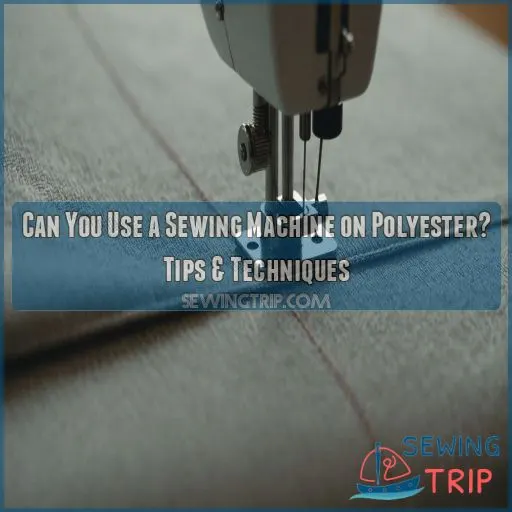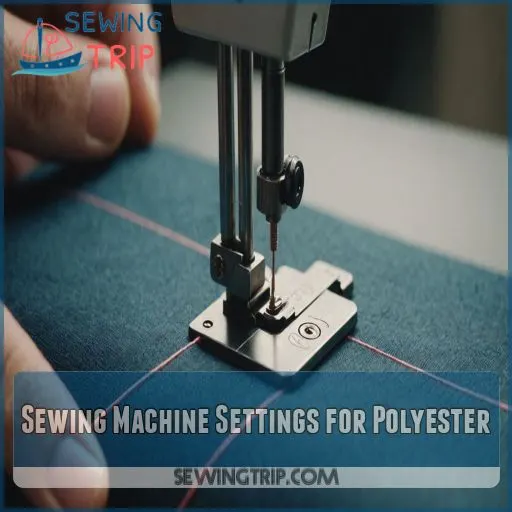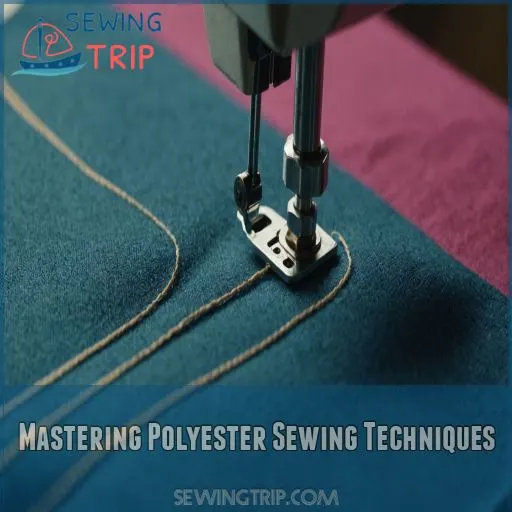This site is supported by our readers. We may earn a commission, at no cost to you, if you purchase through links.
 Absolutely, you can use a sewing machine on polyester! It’s like crafting magic when you’ve got the right setup.
Absolutely, you can use a sewing machine on polyester! It’s like crafting magic when you’ve got the right setup.
Start by picking a universal or ballpoint needle depending on whether your polyester is woven or knit.
Pair this with a trusty polyester thread to avoid any stitch troubles.
Adjust your machine to a medium-length (around 2.5mm) straight stitch for a neat seam like the ones described in this guide.
Little tricks like using a walking foot can keep that slippery polyester from testing your patience.
Feeling like a needle superhero yet? That’s just the beginning—stick around for more pro tips that’ll have you mastering polyester like a pro!
Table Of Contents
Key Takeaways
- You can totally sew polyester with a machine. Just pick the right needle—universal for woven fabrics or ballpoint for knits. It’s like choosing the right tool for the magic trick.
- Polyester thread pairs beautifully with this fabric, preventing stitch fiascos. It’s your fabric’s best friend, making sure everything stays together seamlessly.
- Avoid fabric slippage and puckering by using a walking foot or some temporary spray adhesive. It’s like having an invisible assistant that keeps everything in line.
- Pre-washing in cold water, being gentle with ironing, and practicing on scrap fabric can save you from headaches later. Think of it as your sewing warm-up routine.
Sewing Machine Settings for Polyester

Sewing polyester fabrics doesn’t have to be a headache, especially if you use high-quality thread. With the right sewing machine settings, you can tackle those slippery, tricky polyester projects with ease.
Choosing the Right Needle Type
Choosing the right needle is like choosing the right wand—it’s essential!
Use a universal needle for woven polyester fabrics.
Pick size 11/75 for light fabric and 80/12 for thicker ones.
If you’re diving into knits, grab a ballpoint needle to avoid snags.
Thread Options for Polyester Fabrics
You’ve nailed the needle type, now let’s chat about thread.
Aim for polyester thread—it matches well with synthetic fibers.
Choose a trusted thread brand like Gutermann for reliability.
A 50-weight thread is your versatile buddy, but 40-weight serger thread steps in for turbo-speed sewing!
Match thread color for seamless disguise.
Seam Finish Techniques for Polyester
For a smooth finish with polyester, think of seams like fancy wrapping for your fabric.
Use a zigzag stitch or try serging for an overlock stitch that keeps edges neat.
French seams add elegance, while bias tape brings a professional touch.
Common stitches on your sewing machine can tackle the challenge, ensuring polyester’s edges don’t fray, like those found on a serger.
Easy-peasy!
Stitch Type and Length for Polyester
When sewing polyester, opt for a medium-length (2.5mm) straight stitch.
For stretchy polyester, use a small zigzag stitch with a length of 2.5mm and width of 2mm.
This helps prevent puckering and makes for a smooth, durable seam.
Experiment with your sewing machine settings to find the perfect stitch for your polyester projects, like adjusting stitch length for thicker fabrics.
Pre-Treatment for Polyester Fabrics
Before getting to those perfect stitches, it’s about pre-treatment.
Polyester doesn’t like high temps, so go easy with the iron.
Here’s your game plan:
- Pre-wash in cold water to dodge fabric shrinkage.
- Remove stains promptly to keep colors vibrant.
- Prevent wrinkles by air drying.
- Always test heat settings on a scrap before ironing.
Mastering Polyester Sewing Techniques
Sewing polyester doesn’t have to be tricky if you’ve got the right techniques up your sleeve.
Whether it’s using a double needle hem or a walking foot, you’ll sew through this slippery fabric without slipping yourself!
Double Needle Hem for Lightweight Polyester
Your sewing machine can tackle lightweight polyester with ease using a double needle hem.
It’s like giving the hem a big bear hug for extra strength.
Choose the right stitch length and thread, ensuring your fabric tension‘s not too tight.
Adjust hem width to keep things neat.
Your polyester’s elegance won’t unravel faster than a cat in a yarn shop!
Staystitching for Curved Seams
Staystitching is your secret weapon for taming those pesky curved seams on polyester. This simple technique stabilizes the fabric, preventing stretching and distortion as you sew. Just stitch a line of stitches 1/4 inch inside the seam allowance, following the curve. It’s a game-changer for keeping your polyester projects looking sharp!
- Stitch a line of stitches 1/4 inch inside the seam allowance
- Follow the curve of the fabric to stabilize and prevent stretching
- Staystitching is a must-have technique for sewing polyester curves
French Seams for Semi-Sheer Polyester
After mastering staystitching, try your hand at French seams for semi-sheer polyester.
This nifty technique keeps those raw edges tucked away, creating a pristine finish.
Watch out for fabric weight; lightweight sheers require a gentle touch.
Allow for extra seam allowance; you’ve got to fold it back on itself.
A bit tricky? Sure, but totally worth it!
Bias Tape for Professional Finishes
Think of bias tape as the cherry on top for your polyester projects! It adds those professional touches you’ve been dreaming about. Wondering how to apply it? Consider these tips:
- Use different Bias tape types
- Discover creative Bias tape uses
- Try your hand at making DIY bias tape
- Explore Bias tape alternatives
Your sewing machine will thank you!
Walking Foot for Even Fabric Feed
To achieve that professional finish with bias tape, try using a walking foot to keep your fabric slippery-free.
Fabric slippage issues disappear as it pulls the top and bottom layers evenly.
Say goodbye to puckering! You’ll love how smooth your polyester projects look.
It feels like having an invisible helper guiding your sewing machine to victory, especially when you know how to choose the right needle.
Common Challenges With Polyester
Sewing with polyester can present some tricky challenges, but don’t worry – we’ve got your back!
From slippage and puckering to securing those pesky seams, we’ll walk you through the solutions to make your polyester projects a breeze.
Slippage and Puckering Prevention
Prevent slippage and puckering on polyester fabric with these quick tips.
First, keep your fabric tension balanced—loose tension can be a stitch’s worst enemy.
Use a walking foot to maintain even fabric feed.
Try adjusting seam allowance and stitch length for smoother results.
Master pinning methods to keep your pieces aligned, making sewing a breeze.
Happy sewing!
Temporary Spray Adhesive for Easier Sewing
Exploring slippage is a bit like trying to catch a greased pig—frustrating! Enter temporary spray adhesive for easier sewing. It’s your secret weapon, making polyester a breeze.
- Spray adhesive application: A quick mist does wonders.
- Spray adhesive benefits: Secure, easy-to-sew fabrics.
- Spray adhesive alternatives: Try fabric glue sticks.
Say goodbye to polyester headaches!
Starting on Scrap Fabric for Smooth Seams
So, you’ve got temporary spray adhesive under your sewing belt.
Now, let’s chat about starting seams on scrap fabric.
It’s like a warm-up lap for your machine, preventing thread tension snafus and puckering.
Perfect for sewing beginners and pros alike, this trick keeps stitch length consistent and smooth.
Give it a shot; it’s a game-changer!
Backstitching for Secure Seams
Why not backstitch at the start and end of your polyester seams?
This simple technique secures the stitches, preventing unraveling.
Just a few extra backstitches will give your seams added strength and durability.
Plus, it’s a breeze to do – just reverse your sewing machine a few stitches at each end.
Easy peasy!
Troubleshooting Common Polyester Issues
Ah, polyester fabric—a slippery customer!
When dealing with seam puckering, adjust your sewing machine settings.
Try a walking foot or temporary spray adhesive to avoid fabric slippage.
Choose the right thread for balance.
If stitches won’t behave, sew on scrap first.
Essential Tools for Sewing Polyester
Sewing polyester can feel like wrestling a slippery eel, but with the right tools, you’ve got the upper hand. Fabric shears are your trusty sidekick for cutting clean lines. A rotary cutter offers precision and speed for those who love adventure. Keep a seam ripper close—it’s like your "undo" button for stitches.
Pressing tools mightn’t sound thrilling, but they help keep polyester tamed and wrinkle-free. A specialized sewing machine foot, like a walking foot, makes sure even fabric feed.
Don’t underestimate your fabric tape measure or sewing pins; they keep things steady, as does a needle minder keeping track of those pesky needles. With these tools, you’ll ditch frustration and sew polyester like a boss.
Frequently Asked Questions (FAQs)
What type of sewing machine needle for polyester?
Grab a universal needle for woven polyester fabrics—choose size 11/75 for thin ones or 80/12 for thicker types.
For knits, don’t skip the ballpoint needle.
With the right needle, you’ve got this!
What is the best sewing machine setting for polyester?
Perfect polyester settings? Precision prevails! Use a universal needle, size 11/75 for thin or 80/12 for thick.
Select a medium straight stitch, 5mm, or a small zigzag if it’s stretchy.
Polyester thread helps create a flawless finish!
Do you need a special needle to sew polyester?
A universal needle works well for woven polyester—choosing size 11/75 for thin fabrics, 80/12 for thicker ones.
For knits, use a ballpoint needle.
It’s like choosing the right shoe for an outfit!
Why is my sewing machine not stitching polyester?
Ah, tricky polyester giving you trouble, huh? Don’t sweat it – try switching to a finer needle, adjusting your tension, and taking it slow.
With a few tweaks, you’ll be sewing that slippery stuff like a pro in no time.
Can you dye polyester fabric?
Dyeing polyester can be like trying to teach a cat to fetch. It’s tricky due to its synthetic nature.
You’ll need special disperse dyes and heat—usually boiling water—to effectively color polyester fabric successfully.
How to clean polyester fabric?
Cleaning polyester fabric is a breeze! Just toss it in the machine with cold water and mild detergent.
Avoid hot settings and high heat—polyester hates that and might melt.
Tumble dry low or air dry for best results.
How to fade polyester fabric?
Think of polyester as a rebellious teenager; it’s tough to tame.
You’ll need patience.
Use a color remover or bleach alternative, always test first.
Natural fading occurs under sunlight—but like sunbathing, moderation is key!
How is polyester made into fabric?
You can absolutely sew polyester fabric on a sewing machine!
Just be sure to use the right needle, thread, and stitch settings.
With a little practice, you’ll be whipping up polyester projects like a pro in no time.
How to iron polyester fabric?
Turn your iron to low heat, like tiptoeing on eggshells, and use a pressing cloth to protect the fabric.
Quick presses, not glides, prevent shiny marks on polyester.
Avoid steam, lest you risk water spots.
Conclusion
Picture yourself confidently gliding over fabric like a sewing maestro.
Yes, you can use a sewing machine on polyester, and it’s simpler than you think!
With the right needle, thread, and a few clever techniques, you’ll conquer challenges like slippage and puckering.
Your trusty sewing machine, armed with a walking foot, reduces frustration as you create dreamy polyester garments.
Let’s get started with these strategies, and your polyester projects will turn out polished, professional, and maybe even fun!









